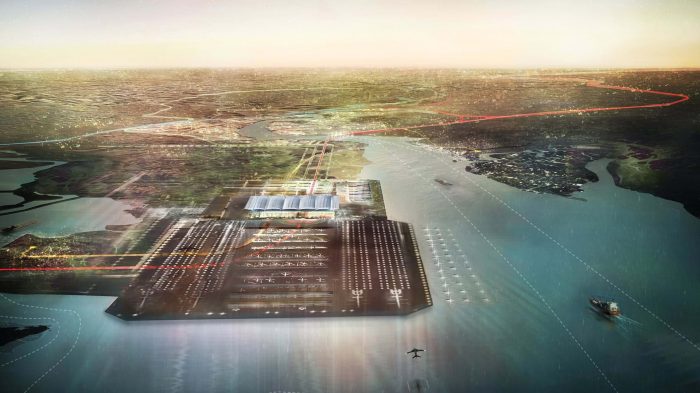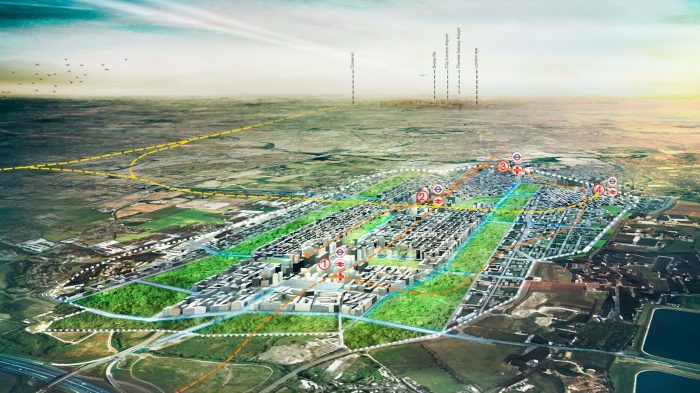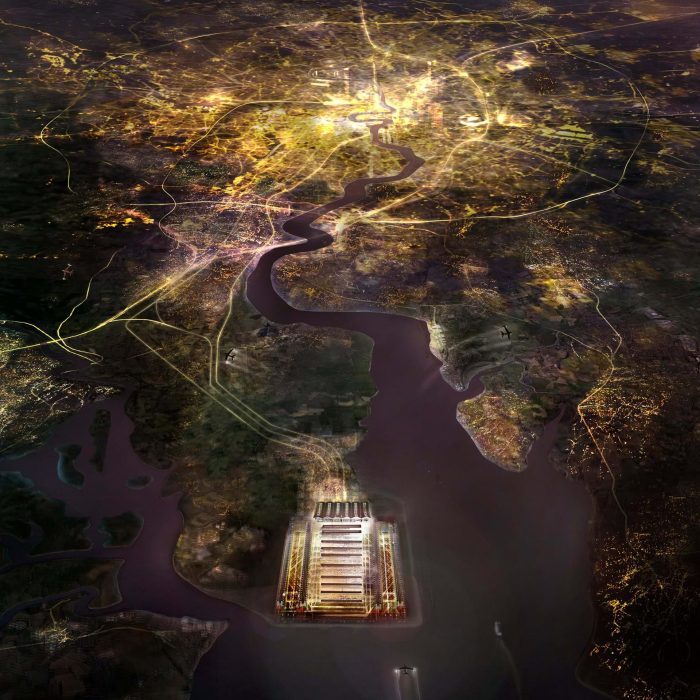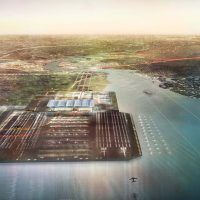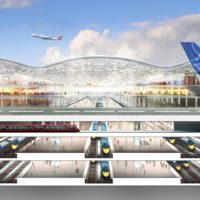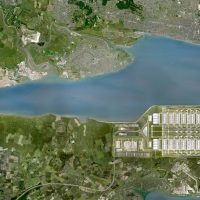Thames Estuary Airport
First some background info, London has three principal airports, Heathrow, Gatwick and Stansted. They are located too close to the built-up areas so requiring aircraft to fly low over London. As London being an economical capital of Britain, several locations for a new airport have been proposed in the Thames Estuary, to the east of London.
Foster and Partners have proposed a bold new approach to future infrastructure development in Britain, the Thames Hub. It will bring together rail, freight logistics, aviation, energy and its transmission, flood protection and regional development. New vision includes a new orbital rail link around London, which would connect with a future high-speed rail line from London to the cities of the Midlands and the North, opening up a direct connection to continental Europe. Freight distribution network created by this new vision will put Britain at the center of manufacturing distribution, as well as releasing pressure from roads and commuter services.
A new international airport located in the Thames Estuary on the Isle of Grain would benefit from these new linkages. The proposed airport would satisfy the capacity needed today and also allow for future expansion, while reducing the environmental and security problems of aircraft over flying London, which is a major issue in the current airports of London. Without adding visual clutter to the rural landscape a new distribution networks for power, utilities and data are needed across the country. Lord Foster’s new integration delivers a solution for it by incorporating data cabling, water and energy distribution routes integrated with the rail and road network in the ground, invisible in the landscape, simple to maintain and easy to secure.
Moreover, a new flood barrier in the Thames Estuary is also required, which has the potential to deliver comprehensive improvements and secure London from future floods. It can solve the shortage of housing by creating new flood protected land for residential development, provide a platform for an integrated rail and road network to establish new trade routes between the country and Europe, generate renewable energy from tidal flows and bridge the Estuary to create a new corridor for utilities, communications and data. The proposal includes a detailed study of wildlife habitats in the Thames Estuary, investigating the potential for a new natural reserve, analyzing of the wreck of the SS Richard Montgomery, a World War II munitions ship, which lies close to the proposed airport site, a survey of the settlements and listed buildings on the Isle of Grain and studying further details on rail alignment and integration of utilities and gas insulated cables, and possible locations of intermodal stations on the Orbital Rail link.
All of these aspects cannot be neglected, and they are indeed an important advantage to the country. The new airport could allow 24 hour operations, also easily expandable as demand grows and it commences a shift in the Economic geography of the South East of England. Surprisingly, despite all of these promised benefits, the Commission has found in its 18 months long examination, few people outside the direct advocacy groups support the idea. The aviation industry doubts the viability of the plan, local councils are opposed, and business groups are similarly unenthusiastic. At the end of this hefty calculations, different state of inquiries and data collection, the Airport Commission concluded that, “in view of the obstacles to delivery, high costs and uncertain benefits we will not shortlist a scheme for further consideration“.
Lord Foster’s remarks on the Verdict, “elsewhere in the world, relocating an airport that no longer serves its purpose is considered normal practice. France did it twice in a matter of decades. In Hong Kong, we created a man-made island the size of Heathrow and built what was then the largest airport in the world – all in the space of six years. The pattern of the most competitive emerging economies is to replace the old and obsolescent and go boldly forward with the new, an opportunity today’s decision denies this country. The outcome of this process calls into question the validity of the Commission“.
As per the report by the Airport Commission, they are not persuaded that a Hub Airport in the Thames Estuary is the right answer to London’s and Britain’s connectivity needs, and the Airport would need to be very large to justify the enormous costs involved, both for the Airport itself and the surface transport connections to it. Interim Report argued that London need one net new runway by 2030, and that additional capacity on that scale can be reconciled with the Country’s climate change commitments. The delivery risks of such a massive project including its surface transport links are very great and the economic disruption would be huge. There are also challenges in relation to the practicality of operating a very large hub airport in the Estuary, for example, risk of bird-strike and average rail journey to the airport would be 20-25 percent longer than is the cast today. Also the cost, least ambitions version of the scheme would cost almost £70 to £90 billion with much greater public expenditure than involved in other options probably some £30 to £60 billion in total. More ambitious schemes would cost considerably more.
So at the end, there are two mindsets of looking at the project, London may have missed an opportunity for a Great Leap Forward, and that the Commission lacks ambition and imagination. Another would be in favor of the Commission that solutions which are deliverable, affordable and set the right balance for the future of aviation in the Britain.
Project Information:
Architect : Foster and Partners
Project Year : 2011
- Courtesy of Foster and Partners
- Courtesy of Foster and Partners
- Courtesy of Foster and Partners
- Courtesy of Foster and Partners
- Courtesy of Foster and Partners
- Courtesy of Foster and Partners


